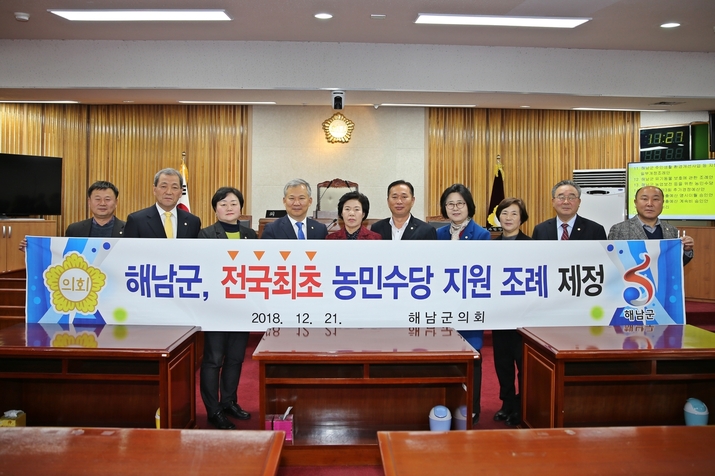 |
|
Starting in June, Haenam County, South Jeolla Province, will provide an annual farmer’s allowance of 600,000 won (US$515.32) to over 15,000 farms, the first of such allowances in South Korea. (provided by Haenam County)
|
Around 60 counties to follow suit with similar plans
Farmer’s allowances appear poised to spread nationwide following their scheduled introduction this June in Haenam, South Jeolla Province. Around 60 mayor and county government candidates pledged allowances during last year’s local elections on June 13, and politicians appear highly likely to include plans for their institutionalization as pledges for next year’s general election. Haenam County announced on May 3 that it would be “paying out South Korea’s first farmer’s allowances as of next month.” The same day, the county received notification of discussions with the Ministry of Health and Welfare announcing that the allowances “can be pursued as a pilot effort.” The discussions were held after some contended that the allowances, which were being pursued as “agricultural policy,” actually constituted a form of social security. With the institutional obstacle now out of the way, the county will begin receiving allowance applications from individual villages through May 10. Through the end of June, certificates worth 600,000 won (US$515.32) are to be paid via the National Agricultural Cooperative Federation (Nonghyup) to up to 15,000 farming households. To uphold Nonghyup’s public service role, farmers receiving allowances are obligated to maintain the current state of their paddies/fields and other farmlands, comply with regulations on suitable livestock farming density, and engage in safe food production. Over the past year, the county set up a “farmer’s allowance pursuit committee” with around 20 members from different fields to establish the scope of the allowances, enact a related ordinance, and ensure the necessary budget. The system’s introduction in Haenam, which has the largest area of farmland in South Korea, is seen by farmers as representing symbolic progress. Accordingly, around 100 local governments nationwide – including Sangju in North Gyeongsang Province, Wonju in Gangwon Province, Yeoju in Gyeonggi Province, Gochang in North Jeolla Province, Buyeo in South Chungcheong Province, and Jinju in South Gyeongsang Prince – are studying the Haenam precedent. The neighboring South Jeolla counties of Hampyeong, Gwangyang, and Hwasun are set to pay out their own farmer’s allowances of around 1.2 million won (US$1,030) before the end of the year. “The farmer’s allowances are not a case of pork barrel spending, but a policy measure to prevent the loss of population and the disappearance of farmland in the agricultural communities that are the breadbasket of the South Korean people,” said an official with the county’s agricultural administration department. “Given the intense level of interest in agricultural regions, it feels like only a matter of time before [the system] expands nationwide,” the official added. Provincial-level governments in North and South Jeolla, Gyeonggi, and South Chungcheong are also commissioning studies and preparing ordinances to introduce farmer’s allowances as of next year. Political parties, including the Democratic Party, Justice Party, and Minjung Party, are fine-tuning plans for farmer’s allowance-related pledges in next year’s general election. The Party for Democracy and Peace, which has numerous lawmakers from agricultural regions, has been enthusiastic about related legislation, and Liberty Korea Party members hailing from farming communities have also shown a proactive stance. “With the government removing the obstacles and politicians showing a high level of interest, we look forward to seeing farmer’s allowances spreading nationwide in the near future,” said Park Hyeong-dae, former policy committee head for the Korean Peasants League. By Ahn Kwan-ok, Gwangju correspondent Please direct comments or questions to [english@hani.co.kr]






